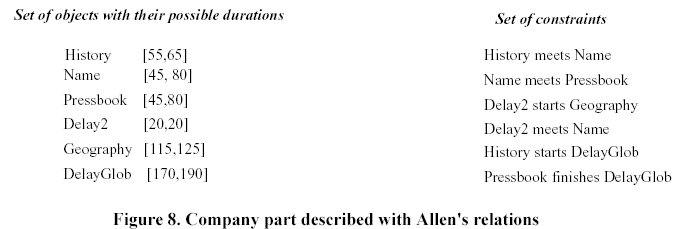|
|
The author declares a set of relations between either instants (=, >, <) or intervals. |
Elastic Time Model:
|
|
each multimedia object can also be associated with a minimum, a maximum and an optimal duration, either chosen by the author or automatically fixed by the authoring system depending on the nature of the object (text, image. video, etc.). |
|
|
first introduced in TemporalGlue and Firefly. |
|
|
For instance, the Company part of our example can be described by the Allen's relations given in Figure 8. The DelayGlob object is a fictive object (without content) which fixes the global duration of the Company part. |

The aim of the temporal formatter(Figure 3):
|
|
check the temporal consistency of this set. |
|
|
compute one solution. |
|
|
Algorithms used for these two phases are issued from either the temporal constraint satisfaction area or linear programming. |
Expressive Power:
|
|
Intuitive way of expression. |
|
|
Can easily capture the temporal information of multimedia documents. |
Autoring Capabilities:
|
|
Modifications of the scenario are made easier since the author has not to reconsider the whole structure but only to add or delete a relation. |
Challenges:
|
|
systems with good time performances. |
|
|
handling local interactions and unpredictable objects. |